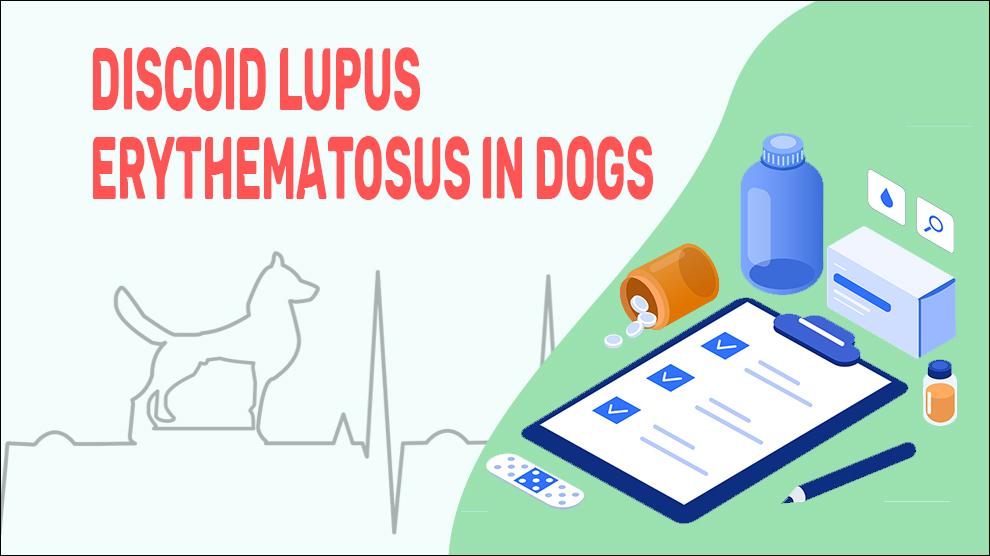Discoid lupus erythematosus (DLE) is an autoimmune, depigmentation, crusting, and scabbing of skin most commonly around the nose, and the normal ‘cobblestone’ appearance of the nose is lost.
This is also called facial or cutaneous lupus erythematosus. DLE is a benign variant of systemic lupus and it is not life-threatening with no systemic involvement. There are two variants of lupus: exfoliative cutaneous lupus and vesicular cutaneous lupus erythematosus. Both these types are relatively rare in dogs.
Symptoms of DLE may mimic that of pemphigus complex, erythema multiforme, mucocutaneous pyoderma (dermatitis that presents due to the use of antibiotics), cutaneous lymphoma, uveodermatologic syndrome, cutaneous drug reaction, solar dermatitis (Collie's nose), tick-borne diseases, systemic fungal infections, amongst others.
Most of the time affected dogs will not have any discomfort or pain; rather the owners will notice unsightly changes around the nose with depigmented, lcerative, crusting, and erosive lesions. In some dogs, irritating lesions may be present around the nose, on the ear flaps (pinnae), and in periocular regions.
Symptoms Of Discoid Lupus Erythematosus
- Loss of the normal cobblestone looks of the nose
- Depigmentation
- Erythema/ reddened patches
- Scaling / crusting as skin developing dandruff
- Erosion, ulceration and crusting of affected region
- Alopecia – loss of hair around his nose
- Initial photodermatitis
Treatment Options For Discoid Lupus Erythematosus
- Cephalexin 10-15mg daily for 1 month.
- Topical steroids such as tacrolimus topical 1%.
- Corticosteroids like oral prednisone or methylprednisolone.
- Alternative steroids for prednisone- and methylprednisolone-refractory cases include dexamethasone and triamcinolone.
- Immunosuppressive drugs, such as cyclosporine, azathioprine, or chlorambucil.
- Nonsteroidal immunosuppressive drugs include tetracycline/niacinamide and gold salts.
Home Remedies For Discoid Lupus Erythematosus
- It is best to avoid the allergens altogether. Pollens and dust (use an air cleaner with a HEPA filter), Molds (place activated charcoal above the exposed dirt in your house plants or use a dehumidifier)
- Medicated baths (weekly or every other week) with medicated shampoos and antimicrobial and antifungal agents relieve injured skin and remove allergens that cause skin allergy flare-ups. Afterward, apply a rinse to prevent drying out of the skin and hair coat.
- Dogs with skin folds can be cleaned daily with a clean, damp cloth, shampoo, wipes, ointment, lotion, spray, skin cleanser, etc.
- Regularly brush the dog to reduce shedding. Consistent grooming spreads the skin’s natural protective oils across the surface.
Prevention Of Discoid Lupus Erythematosus
- Prevention is not possible for DLE.
- Good overall health and early detection are the only ways to prevent this condition.
- Check your dog on a regular basis and consult your veterinarian immediately if you find any odd lumps or lesions.
Affected Breeds Of Discoid Lupus Erythematosus
Collie, German Shepherd, Shetland Sheepdog, Bichon Frise, Maltese, Pekingese, Poodle
Additional Facts For Discoid Lupus Erythematosus
1. Causes:
- Mostly congenital/ idiopathic
- Allergic skin reaction UV light of the sun
2. Mortality:
DLE is not a potentially life-threatening disease in dogs and the mortality rate of dogs is not documented.
3. Diagnosis:
- Routine hematology
- Urinalysis
- Surgical biopsy
- Histopathological examination of the skin
4. Differential diagnosis:
- Pemphigus complex
- Mucocutaneous pyoderma
- Acantholytic actinic keratosis
- Staphylococcal scalded skin syndrome
- Cutaneous lymphoma
- Uveodermatologic syndrome
- Solar dermatitis (Collie's nose)
5. Prognosis:
Depending on the cause and any underlying condition, the prognosis varies ranging from fair to guarded. Dogs that have only a single episode of DLE has an excellent prognosis, on the other hand, in genetically predisposed dogs, the lesions tend to relapse after treatment.
When To See A Vet
Time to visit the vet clinic for an examination, if you notice any of the following:
- Loss of the normal cobblestone looks of the nose
- Depigmentation
- Skin erosions and crusts
Food Suggestions For Discoid Lupus Erythematosus
- Choose a wholesome food, minimally-processed, that is free of preservatives, chemicals, hormones, and other toxic additives. Keep away from butylated hydroxyanisole (BHA) and ethoxyquin.
- An allergen-free (hypoallergenic) balanced diet (check for thickeners, coatings, flavors).
- Try an elimination diet after food sensitivity testing. Many prescribed medications for an autoimmune disease can cause GI and non-GI woes.
- Consider a diet with all essential nutrients and also provides plenty of antioxidants (combat free radicals).
- Consider a probiotic supplement with added support for the liver.
Conclusion
In general, most dogs with DLE conditions can be satisfactorily treated. Only in genetically predisposed dogs, it is usually a lifelong condition requiring continuous management.
After immunosuppressive therapy is tapered and discontinued, some dogs may remain in remission and they require lifelong therapy to maintain remission. Usually, the prognosis for dogs with DLE remains good depending on the response to therapy, adverse response to treatment, and co-morbidities.

















